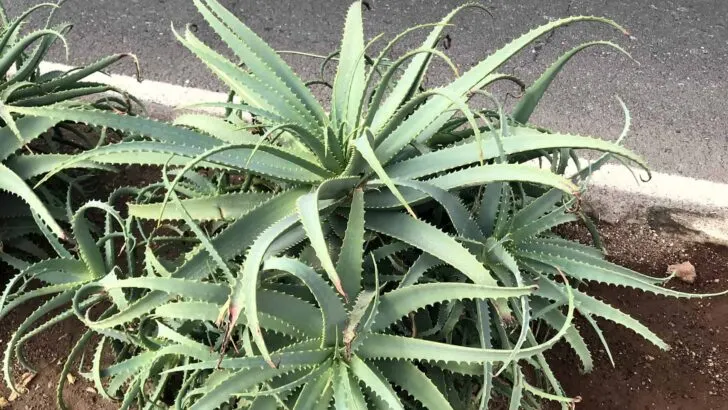Aloe vera or Aloe barbadensis is a succulent that can be cared for as a houseplant or outdoor plant, depending on your climate.
The Aloe vera plant is a succulent that belongs to the Aloe genus. Its thick fleshy green leaves and little stems have a distinctive look. The leaves are star-like and orientated in all directions. Its leaves are equipped with little thorn-like spikes along the edges.
Aloe vera Takeaways
| Species | Aloe vera |
| Synonyms | Acemannan, Aloe africana, Aloe arborescens Miller, Aloe barbadensis, Aloe barbadesis, Aloe capensis, Aloe-coated gloves, Aloe Ferox, Aloe Gel,Aloe Latex,Aloe Leaf Gel,Aloe mucilage,Aloe natalenis, Aloe Perfoliata, Aloe Perryi Baker,Aloe saponaria, Aloe spicata |
| Family | Asphodelaceae |
| Genus | Aloe |
| Growth | Rosette, clumping |
| Height | 2 feet |
| Width | 3 feet) |
| Soil | Well-draining soil mix |
| Watering | Every 14-21 days |
| Light | Bright indirect |
| Temperature | 60-85 °F (16-29 °C) |
| Humidity | 30-50% |
| Fertilizer | Fertilize every 2-3 months in spring and summer |
| Propagation | Offsets or stem cuttings |
| Toxicity | Aloe vera is toxic to cats and dogs. It contains polysaccharides and phenolic chemicals |
Table of Contents
How to care for an Aloe vera plant
Aloe vera plants thrive in well-draining soil and require minimal watering, especially during winter. When repotting, choose a pot slightly larger than the plant’s current container to prevent overwatering. Fertilize with a weak plant food every 2-3 months from April to September for optimal growth. Regularly wiping the leaves with a damp cloth will help prevent dust buildup and keep the plant healthy.
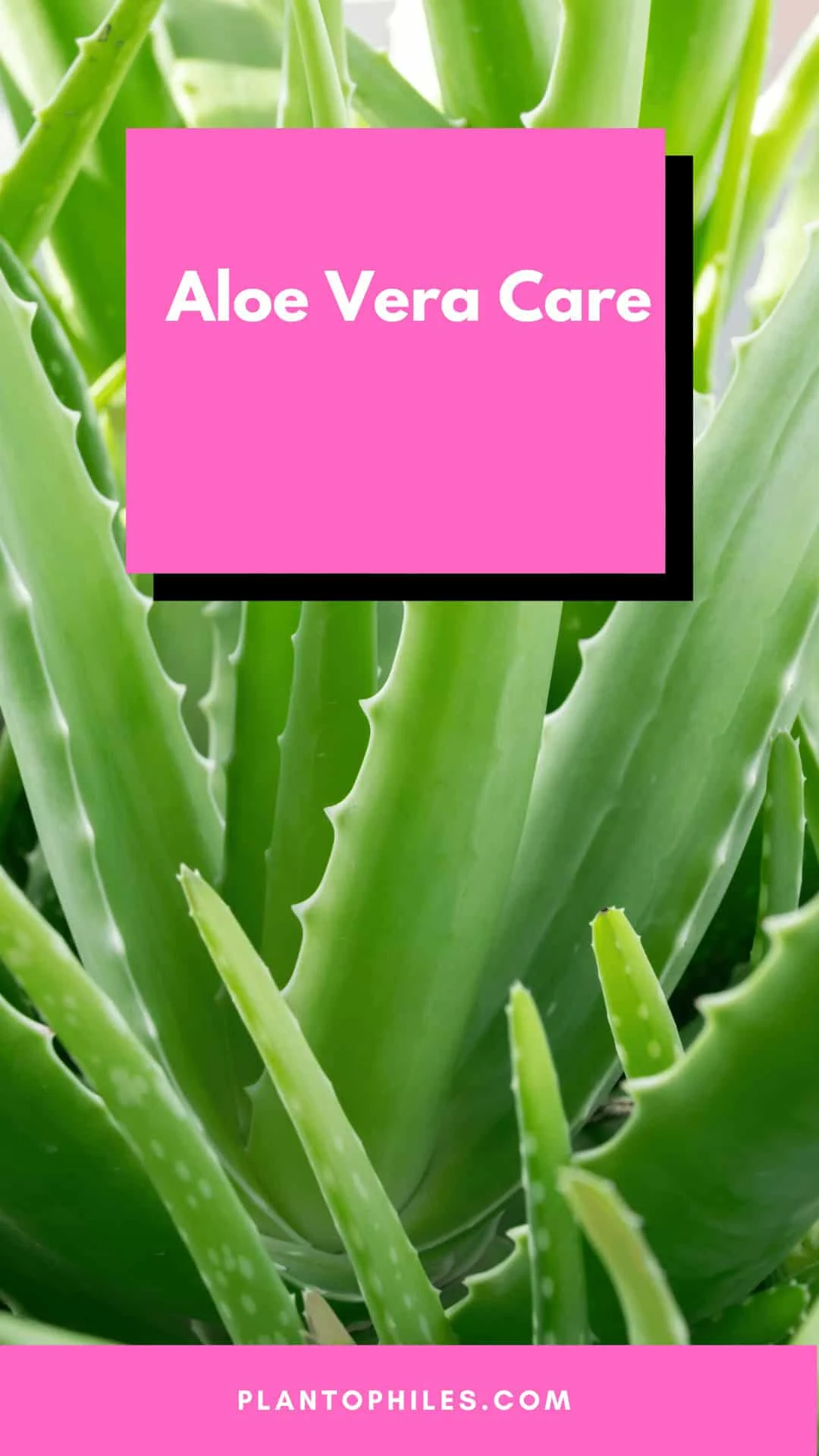
Aloe Vera is appreciated as a home remedy and as a beauty product. It is said to have multiple medicinal properties gained from the Aloe vera plant leaves.
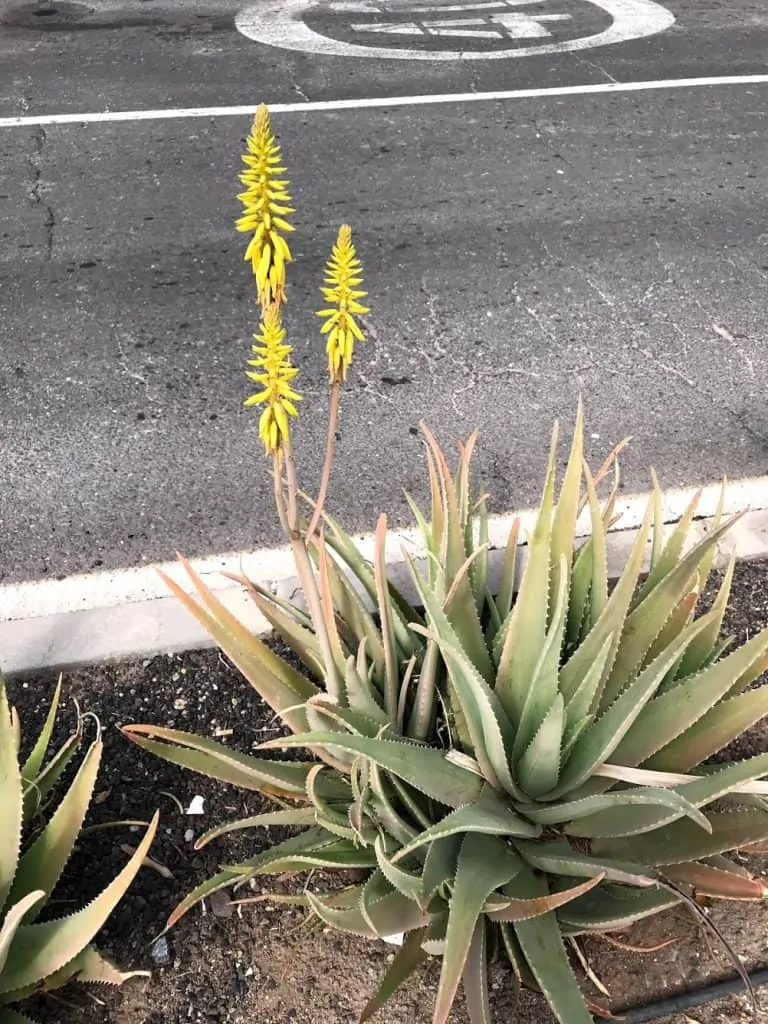
Soil for Aloe Plants
A succulent or cacti potting mix is best. You can make your own if you do not want to rely on a pre-made soil mix. Mix equal parts of sand and potting soil; you have your Aloe Vera potting mix.
Aloe Vera Light
Aloe Vera prefers bright sunny spots. Too much shadow and growth will be reduced drastically. Do not put your houseplant into direct sunlight for too long. Although Aloe Vera is an after-sun cream, it can still be burnt by too much direct sunlight.
It is fine to place your Aloe Vera outside for summer but look for a spot that doesn’t get more direct sunlight than a couple of hours. Close to a south or west-facing window is best when keeping your plants indoors. Light is important as Aloe Vera plants grow leggy; otherwise and will start to look unattractive.
If you cannot provide sufficient light indoors, you can always revert to a grow light, as they will do a good job of keeping your Aloe Vera plant happy.
Watering an Aloe Vera
Water extensively once the soil is dry every 2-4 weeks. Ensure the water drains well, as wet feet will not be tolerated. Moist soil will cause root rot in no time. Overwatering often kills this desert plant, as underwatering is hard to do.
It stores a lot of water in its leaves. When keeping your Aloe Vera outside, you won’t need to water it. Nature will take its course unless you live in an inhabitable place where it doesn’t rain all year.
Reduce watering in winter as the plants will go into dormancy.
Related: Do you water Aloe Vera from top or bottom?
Temperature
The best temperature for an Aloe Vera is 60-75ºF (16-24ºC). Aloe Vera can be placed outside if you are living in a hardiness zone 10+, according to the USDA plant hardiness website. Aloe Vera does not tolerate freezing temperatures. Minimum temperatures should not be below 30ºF (8ºC).
Humidity
Aloe vera is a succulent and can, therefore, be kept as you would keep cactus. They like it dry, and most homes’ general humidity or dryness will be fine.
Fertilizer
Fertilize every 2-3 months in spring and summer using a weak fertilizer. Do not fertilize in autumn and winter.
Propagation
Aloe Vera is a great and easy plant to propagate. That is one of the main reasons Aloe Vera care is so enjoyable. It produces little plantlets called pups that will start to grow from your main plant without you needing to do anything. Once they reach several inches, you can start separating them from the mother plant.
In the best case, they will already have separate roots once you remove the dirt below the Aloe Vera pups. Once you remove the dirt below the plantlets and set free the roots, you can cut the connection to the mother plant.
A different technique is propagating plants directly from leaves. This technique is considered more advanced, and the chances of success are much slimmer.
Growth
Aloe Vera plants reach a height between 2′ – 3′ feet (61 – 91cm) and can reach considerable weight based on their leaves storing a lot of water/gel. Rotate your Aloe Vera every couple of months to ensure it grows evenly. Aloe Vera plants are slow growers, and it takes a lot of time until a small plantlet called Aloe pup reaches a considerable size.
To increase the growth rate it is best to keep the plants outside in the summer when the temperatures allow it.
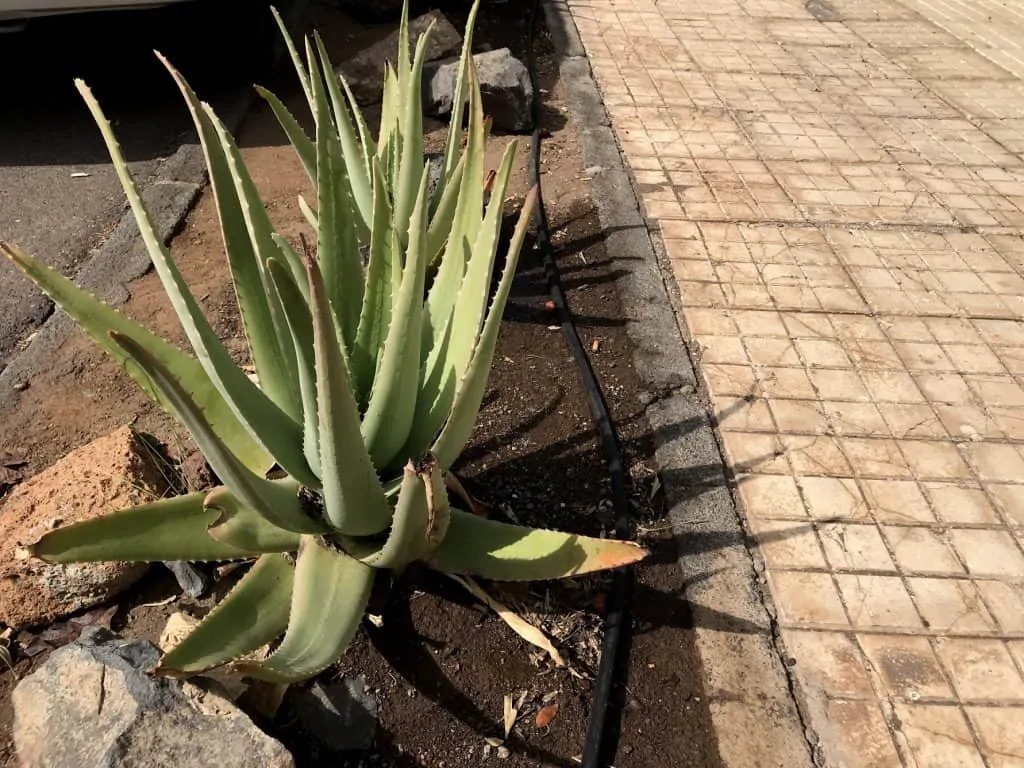
Potting
Use a terracotta pot for the Aloe Vera care if possible. Terracotta pots are porous and tend to dry out quicker. Aloe Vera doesn’t like to stay too humid for too long. That’s why Terracotta pots are ideal. In addition, make sure your pot has drainage holes.
This prevents your plant from staying in sogging soil. You will not have to report often as Aloe Vera doesn’t have an extensive root system and loves to be planted in a tight space. This will also increase the chance of producing Aloe pups. Also, make sure that your Aloe Vera is not tipping over.
The bigger and heavier the fleshy leaves get, the more important it will be that the plant doesn’t lose its balance.
Aloe Vera Plant Propagation
Aloe propagation is easy if you do it by division. That means in the case of Aloe Vera that you are separating the plant pups from the mother plant. The plantlets start to emerge from the base of the plant.
We recommend waiting until the aloe plantlets reached a certain size and have started to develop their own roots. This way, the success rate increases quite a bit.
The other method is propagation by leaf cuttings. We have never done it successfully, and there seems to be quite some controversy if it is even possible to propagate Aloe Vera using leaf cuttings.
Propagation is best done in spring and summer, when Aloe Vera grows the most and propagation is most successful. Roots will grow quicker because it is warmer and brighter than in winter and autumn.
When does the Aloe plant start to produce plantlets?
The older your Aloe plants get, the more plantlets, offshoots, or suckers they will generate. These are all names for the little Aloe plants that start to grow from the base of the mother plants.
Interestingly very small plants already start to produce other Aloe Vera plants. The healthier it is, and the more light the plant gets, the bigger the chance of offspring is.
The Step-by-Step Aloe Vera Plant Propagation Guide
- Remove the dirt along the Aloe plant
- Untangle the roots of the mother plant as well as of the offshoots
- Get a clean knife or scissors and cut the plantlet off as close to the big Aloe Vera as possible
- Remove as much of the dirt as possible
- Once the plantlets are untangled and all the dirt is removed, inspect the roots
- If there are little to no roots, make use of cinnamon or rooting hormone to encourage root growth
- Prepare some cacti or succulent soil and fill it in a small terracotta pot
- Gently make a hole in the soil. This is where you will put your plantlet
- Push the soil around the pup against it slightly so it holds steady
- Slightly water the soil so it is humid but not sogging wet as the Aloe Vera pups will have little to no roots to start with
- Wait until the soil is almost dry before watering
- After 3-4 weeks, slightly pull the Aloe Vera to test if the roots have started to grow
- If new roots start to grow, you can care for your pup as you would for a regular Aloe vera
The great thing is that Aloe is very productive, and you will have multiple new plants very soon and can share them with friends and family, or you find yourself some friends online and swap plants with them. A good swap for an Aloe Vera would be a Spider plant.
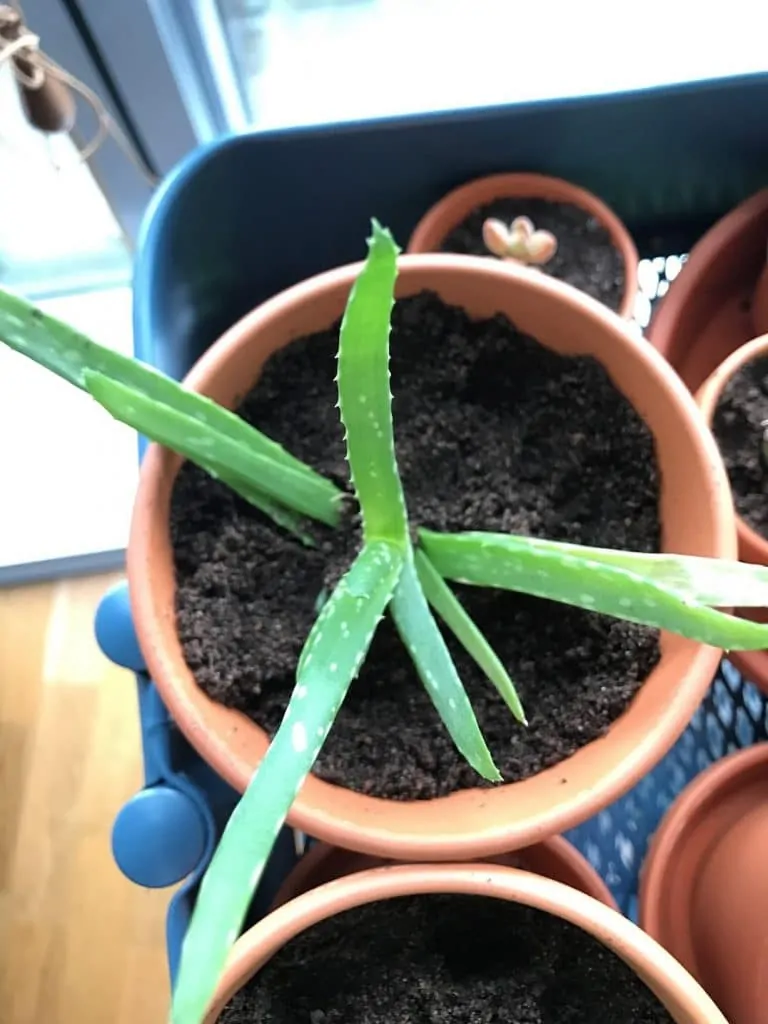
Aloe vera care outside
You can plant your Aloe in an area with direct sunlight. Dry sandy soil with rocks is best as it will allow water to drain around the plant. When moving an Aloe Vera from indoors to outdoors, make sure that you are acclimating your plant slowly and gradually increase the amount of light the plant gets by moving it to more and more sunlight every couple of days until it is adapted to full sunlight.
When an Aloe gets too much sunlight, it can turn orange or brown. This is an indicator that the amount of sunlight is insufficient. This can often be seen in very hot and warm places.
Aloe vera Plant Pests
Aloe Vera is prone to be attacked by plant pests. Its fleshy, thick leaves are a feast for multiple plant pests such as aphids, scale, mealybugs, and mites. In the following paragraphs, learn how to spot, treat, and prevent an infection. This Aloe Vera care section is dedicated to pests.
Aphids on Aloe vera
For healthy Aloe Vera plants, a small infestation with aphids is no big deal. But the larger the population and the unhealthier the Aloe, the bigger the issue of an aphid infestation. Aphids are planted juice-sucking insects and love Aloe Vera plants with their fleshy leaves.
Aphids are pear-shaped and can be spotted using a magnifying glass.
Scale problems with Aloe
Scale are a common problem with succulents. They are small flat insects that feast on plant tissue and sap. When talking about scale and succulents, we mostly talk about soft scales.
Scale is sucking on the plant juice and will damage the health of the Aloe Vera and lead to stunted and crippled growth and discoloration. Scale is not moving and will remain where they were hatched.
For the untrained eye, they are difficult to spot as they do not look like insects and can be confused with natural spots on plants. To get rid of scale, it is best to get a dull knife and scrape them off.
A different method that works for most plant pests is to take a cotton swab that you put into rubbing alcohol. Swipe the plant with it, and you should eliminate the nasty scale infestation.
Mealy Bugs often attack Aloe vera
Mealybugs see Aloe Vera as a big buffet. They very much enjoy feeding on the fleshy leaves. You can spot them by looking out for white web-like constructions on leaves. They like the crevices and often hang out where the leaves meet the stems.
Mealybugs will move quickly and will infest plant by plant. You must be moving even quicker.
A cotton ball with rubbing alcohol and spritzing your plant with water, and then wiping it off with a cloth is a good way to get rid of a mealybug colony fast.
Aloe vera infested with mites
Mites are small, tiny insects. There even is a specific type called the aloe mite. Some types of mites, such as gall mites, have the potential to do extensive damage to plants.
The worst case is that you must dispose of your plants entirely depending on the damage caused. It is good practice to isolate and quarantine infected plants to prevent the spread to still-healthy plants.
How to get rid of a pest infestation
Aloe Vera plants are very sensitive, and you should refrain from using pesticides. If your Aloe has a pest problem, it is best to use diluted rubbing alcohol.
Clean the leaves and the surface area of your plant and repeat it after about two weeks to ensure that any mealybug, scale, aphid, or whatever pest attacked your Aloe vera plant is completely gone.
Even using straight water to wash off your plants is a good way to get rid of unwanted insect infestations.
The best way to prevent pest infestations is to keep your plants healthy and happy. This way, even if your plants get infected, there is a good chance they will survive the attack. On the other hand, a healthy plant does not guarantee it will not get sick.
Therefore make it part of your routine to search your plants weekly for pests. This way, you will spot infestations earlier than later, and you can react quickly to condemn colonies of insects building up and spreading to large parts of your plant collection.
Aloe vera Plant Benefits
Apart from Aloe Vera care, many benefits are associated with Aloe Vera. It is often used in after-sun gels and cosmetically, from skincare to hair products. In addition, more and more drinks contain Aloe Vera as it is considered healthy to be ingested.
The part used for all these products is the fleshy leaves containing the slimy aloe gel. This gel contains vitamins, antioxidants, minerals, and amino acids.
Aloe Vera care is easy and Aloe plants are good-looking plants that grow best when neglected. If you can hold back on watering, you can enjoy your Aloes for many years to come and share offspring with your friends for years to come.
What are the most commonly asked questions regarding Aloe vera care?
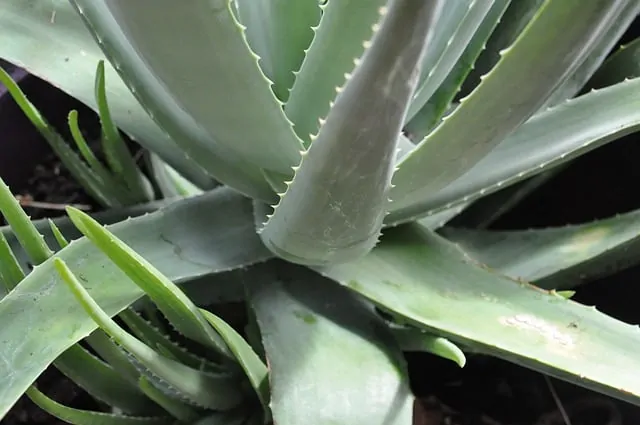
Frequently Asked Questions
Is Aloe vera care easy?
Aloe vera plant care is easy. It grows best when neglected. Make sure not to overwater, as this can lead to root rot.
How often do I need to water my Aloe vera?
Water every 2-4 weeks, depending on your conditions at home. Reduce watering in winter as Aloe Vera goes into dormancy.
How much light do Aloe vera plants need?
Aloe vera has high light needs and should be placed close to a south or west-facing window. It grows well in direct sunlight between 6 to 8 hours. Too much direct sunlight might burn the plant and lead to orange discoloration of the leaves.
Can you grow Aloe vera outdoors?
According to the U.S. Department of Agriculture, Aloe Vera can be grown outside in plant hardiness zones 9 through 11. In zone 9, it will need a sheltered location. Outside of these zones, you can keep your Aloe Vera outside in the summertime.
Is Aloe vera toxic?
Aloe vera can be toxic when ingested and might lead to cramps and diarrhea. It is considered toxic to cats and dogs.
What is Aloe vera good for?
It is considered good for healing wounds and as care for sunburns. It also contains antioxidants, amino acids, and vitamins.
Download the free Alove vera Care Sheet
[download id=”4821″]
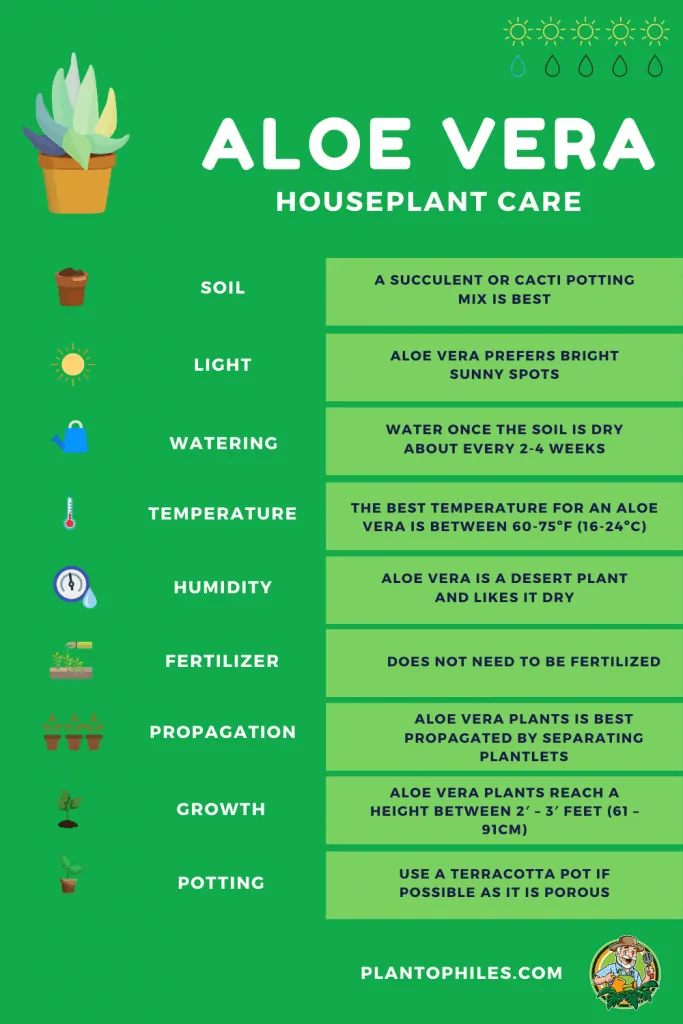

Daniel has been a plant enthusiast for over 20 years. He owns hundreds of houseplants and prepares for the chili growing seasons yearly with great anticipation. His favorite plants are plant species in the Araceae family, such as Monstera, Philodendron, and Anthurium. He also loves gardening and is growing hot peppers, tomatoes, and many more vegetables.

